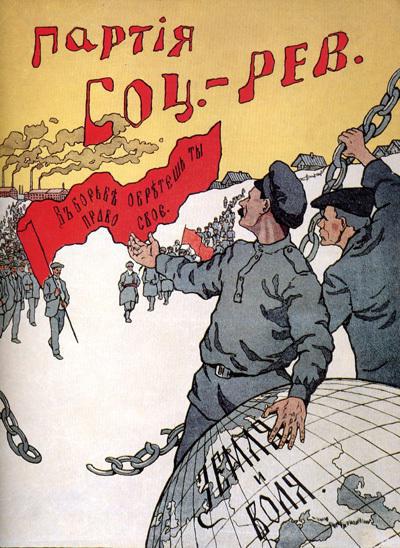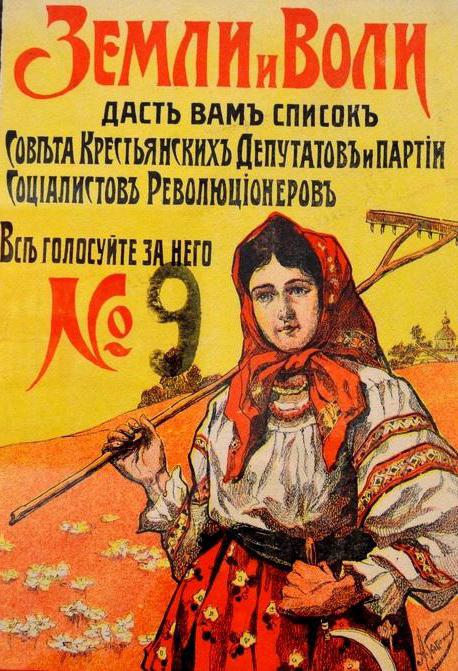At the beginning of the 20th century, in a motley kaleidoscope of domestic political events in Russia, a special place was occupied by the party of socialist revolutionaries, or, as they are called, Social Revolutionaries. Despite the fact that by 1917 they numbered more than a million people, they were not able to realize their ideas. Subsequently, many Social Revolutionary leaders ended their days in exile, and those who did not want to leave Russia fell under the ruthless wheel of Stalinist repression.
Development of a theoretical base
Viktor Chernov, the leader of the Socialist Revolutionary Party, was the author of a program published for the first time in 1907 in the newspaper Revolutionary Russia. It was based on the theories of a number of classics of Russian and foreign socialist thought. As a working document, unchanged throughout the entire period of the party’s existence, this program was adopted at the first party congress, held in 1906.
Historically, the Social Revolutionaries were followers of the Narodniks and, like them, preached the country's transition to socialism in a peaceful way, bypassing the capitalist period of development. In their program, they put forward the prospect of building a society of democratic socialism, in which the leading role was given to workers' unions and cooperative organizations. Its leadership was carried out by parliament and local governments.
The basic principles of building a new society
The leaders of the Social Revolutionaries at the beginning of the 20th century believed that the future society should be based on the socialization of agriculture. In their opinion, its construction will begin precisely in the village and will include primarily the prohibition of private ownership of land, but not its nationalization, but only transfer to public ownership, excluding the right to purchase and sale. It should be managed by local councils, built on a democratic basis, and remuneration will be made strictly in accordance with the real contribution of each employee or the whole team.

The Social Revolutionary leaders considered democracy and political freedom in all forms of its manifestation as the main condition for building a future socialist society . As for the state system of Russia, members of the AKP were supporters of the federal form. One of the most important requirements was the proportional representation of all segments of the population in elected bodies of power and direct popular legislation.
Party creation
The first Socialist Revolutionary Party cell was formed in 1894 in Saratov and was in close contact with the local group of Narodnaya Volya. When they were liquidated, the socialist revolutionaries began independent activity. It consisted mainly of developing its own program and issuing printed leaflets and brochures. The leader of the party of socialist revolutionaries (SRs) of those years A. Argunov led the work of this circle.
Over the years, their movement has gained significant momentum, and by the end of the nineties its cells appeared in many large cities of the country. The beginning of the new century was marked by many structural changes in the composition of the party. Its independent branches were formed, such as the Southern Party of the Socialist Revolutionaries and the Union of Socialist Revolutionaries created in the northern regions of Russia. Over time, they merged with the central organization, creating a powerful structure capable of solving national tasks. During these years, the leader of the party of socialist revolutionaries (SRs) was V. Chernov.
Terror as a way to a “brighter future”
One of the most important components of the party was their “Combat Organization”, which first declared itself in 1902. The first victim was the Minister of the Interior. Since then, the revolutionary path to a "brighter future" has been generously stained with the blood of political opponents. Terrorists, although they were members of the AKP, were in a completely autonomous and independent position.
The Central Committee, pointing to the next victim, only mentioned the expected time for the execution of the sentence, leaving the fighters full organizational freedom of action. The leaders of this deeply conspired part of the party were Gershuni and subsequently exposed provocateur, secret secret agent Azef.
The attitude of the Socialist Revolutionaries to the events of 1905
When the First Russian Revolution broke out in the country , the Social Revolutionary leaders were very skeptical. In their opinion, it was neither bourgeois nor socialist, but was a kind of intermediate link between them. The transition to socialism, they argued, should be carried out in a phased and peaceful way, and only the peasantry, which was given the leading position, as well as the proletariat and labor intelligentsia, could become its driving force. The highest legislative body, in the opinion of the Social Revolutionaries, was to be the Constituent Assembly. With their political slogan, they chose the phrase "Earth and Freedom."

From 1904 to 1907, the party carried out extensive propaganda and propaganda work. A number of legal print publications are issued, which helps to attract even more members to their ranks. The dissolution of the terrorist group "Combat Organization" belongs to the same period. Since that time, the activities of the militants have become decentralized, their number has increased significantly, and at the same time, political killings are becoming more frequent. The loudest of them in those years was the explosion of the carriage of the Moscow mayor, committed by I. Kalyaev. In total during this period, there are 233 terrorist acts.
Disagreements within the party
In the same years, the process of separation from the party of independent structures that formed independent political organizations begins. This subsequently led to a fragmentation of forces and ultimately led to the collapse. Even in the ranks of the Central Committee serious disagreements arose. For example, the well-known leader of the SRs in 1905 Savinkov proposed, despite the royal manifesto, which gave citizens certain freedoms, to increase terror, while another prominent party leader, Azef, insisted on its cessation.
When the First World War began, the party leadership identified the so-called international movement, supported primarily by representatives of the left wing.
It is characteristic that the leader of the Left Socialist Revolutionaries, Maria Spiridonova, later joined the Bolsheviks. During the February Revolution, the Social Revolutionaries, having entered into a single bloc with the Menshevik defenders, became the largest party of the time. They had a large representation in the Provisional Government. Many Social Revolutionary leaders received leadership posts in it. It is enough to name such names as A. Kerensky, V. Chernov, N. Avksentiev and others.
The fight against the Bolsheviks
Already in October 1917, the Social Revolutionaries entered into a stiff confrontation with the Bolsheviks. In their appeal to the peoples of Russia, they called the latest armed seizure of power by madness and crime. The delegation of the socialist revolutionaries left the meeting of the II Congress of Soviets of People's Deputies in protest. They even organized the Committee for the Salvation of the Homeland and the Revolution, which was headed by the famous leader of the party of socialist revolutionaries (SRs) of that period Abram Gotz.
In the elections to the All-Russian Constituent Assembly, the socialist revolutionaries received the majority of votes, and Viktor Chernov, the permanent leader of the Socialist Revolutionary Party in the early 20th century, was elected chairman. The Party Council defined the fight against Bolshevism as a priority and urgent, which was realized during the Civil War.
However, a certain indecision of their actions caused the defeat and arrests. Especially many members of the AKP were imprisoned in 1919. As a result of internal party disagreements, the division of its ranks continued. An example is the creation in Ukraine of its independent party of socialist revolutionaries.
The end of the AKP
At the beginning of 1920, the Party Central Committee ceased its activities, and a year later a process took place at which many of its members were convicted of “anti-popular activities”. The prominent leader of the Socialist Revolutionary Party (SRs) in those years was Vladimir Richter. He was arrested a little later than his comrades.
According to the verdict of the court, he was shot as a particularly dangerous enemy of the people. In 1923, the party of socialist revolutionaries almost ceased to exist on the territory of our country. For some time only its members who were in exile continued their activities.